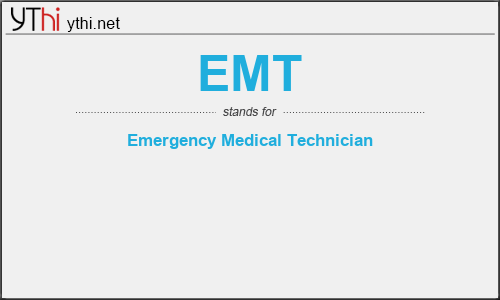What does EMT mean? What is the full form of EMT?
The full form of EMT is Emergency Medical Technician.
Emergency Medical Technicians provide out of hospital emergency medical care and transportation for critical and emergent patients who access the emergency medical services (EMS) system. EMTs have the basic knowledge and skills necessary to stabilize and safely transport patients ranging from non-emergency and routine medical transports to life threatening emergencies. Emergency Medical Technicians function as part of a comprehensive EMS response system, under medical oversight. Emergency Medical Technicians perform interventions with the basic equipment typically found on an ambulance. Emergency Medical Technicians are a critical link between the scene of an emergency and the health care system.
Individuals applying for the Emergency Medical Technician national certification must meet the following requirements:
- Successful completion of a state-approved Emergency Medical Technician (EMT) course that meets or exceeds the National Emergency Medical Services Education Standards for the Emergency Medical Technician.
- Candidates must have completed the course within the past two years and the course Program Director must verify successful course completion on the National Registry website.
- Have a current CPR-BLS for “Healthcare Provider” or equivalent credential.
- Successful completion of the National Registry cognitive (knowledge) and a state approved psychomotor (skills) exams.
- Passed portions of the cognitive and psychomotor exam remain valid for 24 months. For candidates with a course completion date prior to November 1, 2018, passed portions of each examination are valid for 12 months. Provided all other entry requirements are met.
- If the initial Emergency Medical Technician (EMT) educational program was completed more than two years ago, and the candidate is currently state licensed at the EMT level, the candidate must document successful completion of a state-approved EMT refresher course or 24 hours of equivalent continuing education topic hours within the past two years.
- If the candidate is not currently state licensed as an EMT and it has been more than two years from the completion of an approved EMT course, the candidate must complete a new state-approved EMT course prior to applying for National Certification.
Emergency medical technicians (EMTs) and paramedics respond to emergencies, from someone who may be having a heart attack in her home to multi-vehicle accidents on the highway. EMTs are most frequently found in ambulances but some may provide care for patients being transported by air as well.
They provide first-line medical or emergency care for sick and injured people at the scene, which may be in the person’s home, at an accident site or other places and while they are being transported to the hospital for care. They typically operate in teams with one person serving as an emergency vehicle operator while the other continues to provide life-saving emergency care to the patient en route to a medical facility.
The National Association of Emergency Medical Technicians describes four categories of emergency medical practitioners:
- Emergency medical responders (EMRs) are trained in skills to provide immediate lifesaving care for critical patients. Typically, responders can provide on-scene interventions but do not act as the primary caregiver. These EMRs may be members of a volunteer fire department, part of law enforcement, medical reserve corp volunteers or members of an industry response team. Licensure as an EMR requires completion of an accredited training program.
- Emergency medical technicians (EMTs) conduct basic, noninvasive interventions to help save lives and reduce harm at emergency sites. They can do everything a responder does, plus they have the skills needed to transport patients safely. In many places, EMTs provide the majority of out-of-hospital care. To be licensed as an EMT, you must take an accredited course.
- Advanced emergency medical technicians do everything emergency medical responders and EMTs do and can also conduct limited advanced and pharmacological interventions. Advanced emergency medical technicians must complete an accredited course to become licensed.
- Paramedics are the most skilled emergency responders, trained in and capable to do invasive and pharmacological interventions. Licensure requires successful completion of a nationally accredited paramedic program at the certificate or associate’s degree level.
EMT
means
Emergency Medical Technician![]()
Translate Emergency Medical Technician to other language.


Leave a Reply
You must be logged in to post a comment.